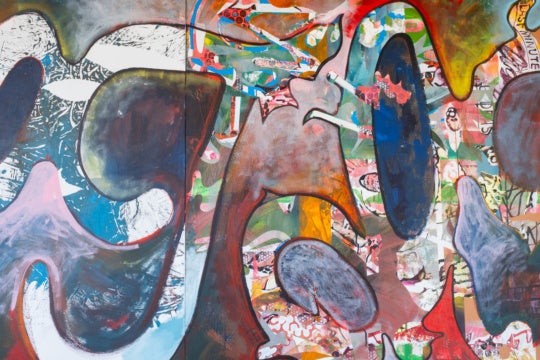
One can only imagine the anxiety involved in organizing an exhibition that responds to the endlessly complex Israeli-Palestinian conflict. That said, Xandra Eden thoughtfully curated “Zones of Contention: After the Green Line” for the Weatherspoon Museum in Greensboro, North Carolina. Because each of the seven artists is somehow personally connected to the Israeli-Palestinian conflict, their viewpoints vary. The show is about experience, and is void of violence or a strong political agenda. Through interviews, metaphor, and gesture, the artists use a new vocabulary to describe their perspectives. Without the shocking and unfortunately familiar imagery of news media, an unexpected opportunity arises—the opportunity to consider the real daily lives of affected people.
The springboard for the show, as referenced in the title, is Francis Alÿs’s work Sometimes Doing Something Poetic Can Become Political And Sometimes Doing Something Political Can Become Poetic. This three-part installation includes a sculpture, a map, and an interactive video that revisits a 2005 performance (and is part of a much larger installation that is in the collection of the Los Angeles County Museum of Art). Originally, Alÿs walked through Jerusalem carrying a leaking can of green paint. He followed the route of the “Green Line” that was drawn on maps following the armistice after the 1948 Arab-Israeli War.
A touch screen allows viewers to select a narrator from a list of 11 people, including activists, architects, and historians, among others. Some of the narrations are formal statements that describe the gesture of the mark making from the perspective of an art historian or architect. Others describe the significance of the armistice agreement, when the Green Line was first drawn. The voiceover in Alÿs’s video gives viewers a chance to consider the Green Line from the narrators’ point of view. The installation also gives a specificity for the other works to build on.
Dor Guez also uses an interview in his work Sa(Mira). He interviews Samira, a young Israeli Arab woman studying at the Hebrew University in Jerusalem, who describes navigating her identity and Arab name while living in an Israeli community. The conversation is intimately held in a living room and is saturated with personal reflection on a current situation of prejudice. The video narrows down a broad and complicated issue to the impact it has on one individual. This is one of a couple of works in the show that relies too much on viewer’s empathy and strays from the ambiguous and unbiased perspective that the show tries to achieve.
Nearby these two dialogue-based works are two videos that utilize gesture. Nina Pereg’s Sabbath 2008 video documents the weekly division within a Orthodox Jewish neighborhood in which residents erect temporary barriers to block local traffic in observance of the Sabbath. Drivers are denied access to public space because of one group’s beliefs. In making allegorical reference to the larger conflict of disputed boundaries, this observational work asks two questions that apply to both this single neighborhood and the division of Israel and Palestine: How far can one go in practicing one’s religious freedom before it infringes on another’s rights? And how does cultural difference segregate a shared space?

Yael Bartana’s video and photographic works are two romantic gestures for peaceful resolution. In the video, A Declaration, a young man removes an Israeli flag on a seaside cliff and replaces it with an olive tree. The olive tree is a metaphor for peace and also recognizes an important shared agricultural resource. The artist, who is Israeli, surrenders her native country’s flag and offers a replacement of common interest. Next to the video is The Missing Negatives of the Sonnenfeld Collection. Eight photographs restaged by Arabs and Jews, the images seem to convey a desire to go back in time to when the original photos were taken, before the establishment of the Green Line. Reenacting the photographs and claiming them to be a part of a collection is an insertion of hopefulness into the past in order to inform the future.
Alongside dialogue and gesture, another conceptual vehicle used in the exhibition is metaphor. A good portion of the gallery’s space was occupied by an archive-style installation by Michael Rakowitz. Beatles memorabilia and artifacts from the Six Days War are spread across glass-topped tables and framed on walls. Notes written in marker on the glass draw connections among the materials by comparing the break up of the Beatles to the history of the United Arab Republic. A documentary and radio series can be found at the-breakup.net. What at first seems like a conspiracy theory evolves into a dynamic metaphor. The artist aligns the band members with nations—like John to Egypt and Paul to Jordan. The substitution of specific people or countries creates a space for the nature of conflict itself to be discussed.

Sharif Waked also uses a subtle metaphor in Bath Time, a looping video projection showing a zebra-painted donkey being washed. The video is accompanied by a wall panel that tells the story of a Gaza Zoo owner whose zoo suffered a great loss of animals and, instead of smuggling zebras in, he painted stripes on the donkeys. Evoking pathos, the donkey stands complacently while he is inefficiently showered. The work humorously points out the complications that come from living in a space of violence and political strife.
“Zones of Contention: After the Green Line” is the second exhibition in a series curated by Xandra Eden after “Zones of Contention: The US/Mexico Border.” In place of statistics or headlines, the works in these exhibitions make space for the viewer to connect with the human element involved in these geographical disputes.
“Zones of Contention: After the Green Line” is on view at the Weatherspoon Museum in Greensboro, North Carolina, through May 3.
Kellie Bornhoft is an artist and writer living in Raleigh, North Carolina.





